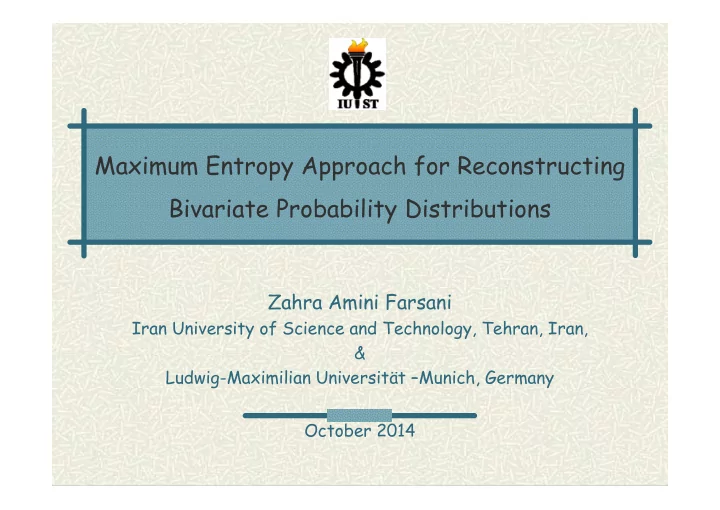

Maximum Entropy Approach for Reconstructing Bivariate Probability Distributions Zahra Amini Farsani Iran University of Science and Technology, Tehran, Iran, & Ludwig-Maximilian Universität –Munich, Germany October 2014
Global Overview Global Overview Purpose Methodology Findings Originality
Purpose Purpose Establishing an accurate and efficient numerical- probabilistic algorithm based on Newton’s technique and Maximum Entropy (ME) method. Maximum Entropy (ME) method. Determining the important bivariate distributions which are very effective in industrial and engineering fields especially in Cybernetics and internet systems.
Methodology Methodology The design of this paper is to construct a new algorithm involving the combined use of a classical numerical approach, involving the combined use of a classical numerical approach, Newton method and a probabilistic method, ME, to find the unique solution of an optimization problem which occurs when maximizing Shannon’s Entropy.
Findings Findings Conducting different simulation studies for determining different classes of bivariate maximum entropy distributions to check the reliability of the proposed algorithm. to check the reliability of the proposed algorithm.
Originality Originality Quantifying a method which deals with how to construct a probability distribution using incomplete set of information. Maximum entropy method is the only way to choose the distribution based on a finite number of expectation of known functions. This method will provide you the unique solution to find a probability distribution based on given information. This is principle of maximum entropy (Jaynes, 1957). MATLAB code for univariate & Bivariate cases.
Contents of Entropy Contents of Entropy Introduction & Review of Shannon Entropy Maximum Entropy Method Maximum Entropy Method
Shannon’s Shannon’s Entropy Entropy
Introduction Introduction Maximum Entropy Probability Distribution is a probability distribution whose entropy is at least as great as that of all other members of a specified class of distributions. Jaynes (1957) has introduced the best approach to ensure that the approximation satisfies any known constraints on the unknown distribution and subject to those constraints, the distribution should have maximum entropy. This is known as the principle of maximum-entropy.
Maximum Entropy Maximum Entropy Maximum Entropy Distribution
Maximum Entropy Maximum Entropy
Maximum Entropy Maximum Entropy
Example Example1: : Bivariate Normal Distribution
Bivariate Normal Distribution
Bivariate Normal Distribution
Bivariate Normal Distribution
Example Example2: : Bivariate Pareto Distribution
Bivariate Pareto Distribution
Bivariate Pareto Distribution
References References [1] Fletcher, R. (1991), Practical methods of optimization, Wiley, New York, NY. [2] Rubinstein, R.Y. (1999). “The Simulated Entropy Method for Combinatorial and Continuous Optimization.” Methodology and Computing in Applied Probability 2, 127–190. [3] E. T.Jaynes, Information Theory and Statistical Mechanics, Journal of Physics.Reveiw. 106 (1957) 620-630. Physics.Reveiw. 106 (1957) 620-630. [4] C. E. Shanonn, A Mathematical Theory of Communication, Bell System Technical Journal , 27 (1948) 379–423. [5] J. A. Thomas, T. M. Cover, , Elements of Information Theory, John Wiley, New Jersey, 2006. [6] Djafari, A. M. (2011), “Maximum Entropy Copulas”, AIP Conference Proceeding , pp. 329-339. [7] Radon, J. (1917), ”ber die bestimmung von funktionen durch ihre integralwerte lings gewisser mannigfaltigkeiten”, Ber. Verh. Sïich. Akad. Wiss. Leipzig , Math. Nat. Kl69, pp.262-277.
Recommend
More recommend